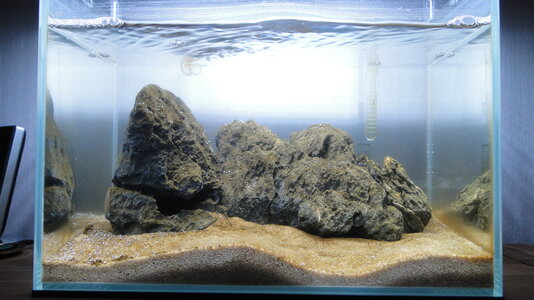Hallo Kolja,
Weiß nicht, ob ich das Bild schon hatte. Schau mal, so sah das zeitweise aus, insgesamt trotz ML/SB und-/NO II wohl algenfrei, mich aber nur mäßig überzeugend. Die Kieselalgen rechne ich nicht zu den problematischen Algen, die hätte ich schon nicht in dem Umfang erwartet, das ist weiters egal, aber siehst du z.B. die Blasen an der Wasseroberfläche? War nicht dolle und bekam erst Richtung als ich etwa 5 halblange Stängel aus meinem gut laufenden Cube drei Tage lang treiben ließ.
Ein Becken jungfräulich aufzusetzen ist so oder so nicht ohne! Im Grunde kannst du nur versuchen erstmal ein Einbringen irgendwelcher Plagen zu vermeiden. Bei dem Becken war das gewaschener Sand, abgekochte Steine, Special Blend und Nite Oute II. In vitro Pflanzen zusätzlich machten dann einen vernachlässigbaren Unterschied. Das geht aber grundsätzlich, das hatte ich mit meinem ersten Leitungswasserbecken auch ohne Impfung aus einem gut laufenden Becken gemacht - ohne Special Blend. Das hatte richtig heftig Kieselalgen und lange eine Bakterienblüte, die ich schneller hätte beseitigen können, wollte das aber nicht, das Becken war dann sehr gut!
Gruß, Nik
ach so, das wäre dann ja im Grunde genau wie mein beschriebenes, pflanzenloses Mini M.WoodyK":14i5ek0u schrieb:Hallo Nik,
an ein paar Tage mit Pflanzen habe ich dabei eigentlich nicht gedacht. Würde die Pflanzen dadurch ja nur schwächen.
Ich dachte da schon an ein paar Wochen ohne Pflanzen. Sauerstoffeintrag durch Oberflächenbewegung und ab und zu etwas Futter rein um das Becken auf eine gewisse organische Belastung vorzubereiten.
Die Überlegung hinter dieser Idee ist für mich halt wie kann möglichst sicher eine gute Mikroflora etablieren ohne diese zu importieren.
Gruß Kolja
Weiß nicht, ob ich das Bild schon hatte. Schau mal, so sah das zeitweise aus, insgesamt trotz ML/SB und-/NO II wohl algenfrei, mich aber nur mäßig überzeugend. Die Kieselalgen rechne ich nicht zu den problematischen Algen, die hätte ich schon nicht in dem Umfang erwartet, das ist weiters egal, aber siehst du z.B. die Blasen an der Wasseroberfläche? War nicht dolle und bekam erst Richtung als ich etwa 5 halblange Stängel aus meinem gut laufenden Cube drei Tage lang treiben ließ.
Ein Becken jungfräulich aufzusetzen ist so oder so nicht ohne! Im Grunde kannst du nur versuchen erstmal ein Einbringen irgendwelcher Plagen zu vermeiden. Bei dem Becken war das gewaschener Sand, abgekochte Steine, Special Blend und Nite Oute II. In vitro Pflanzen zusätzlich machten dann einen vernachlässigbaren Unterschied. Das geht aber grundsätzlich, das hatte ich mit meinem ersten Leitungswasserbecken auch ohne Impfung aus einem gut laufenden Becken gemacht - ohne Special Blend. Das hatte richtig heftig Kieselalgen und lange eine Bakterienblüte, die ich schneller hätte beseitigen können, wollte das aber nicht, das Becken war dann sehr gut!
Gruß, Nik



